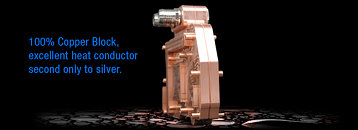Saturday, May 3rd 2008

EVGA 9800GX2 Hydro Copper 18 Waterblock Available for Pre-order
EVGA is proud to announce the first ever EVGA designed GeForce 9800 GX2 water block - the EVGA 9800GX2 Hydro Copper 18 waterblock (part number: 200-CU-HC18-B1) with a 100% copper design and SLI compatibility. Being a full cover block, the Hydro Copper 18 is compatible with all reference 9800 GX2 cards and can be used in both 3/8" ID and 1/2" ID water cooling systems. Available now for pre-order, you'll have to hurry up if you want to buy one, because the block is said to be produced in a limited quantities. The price is little steep though, $249.99.
Source:
EVGA

44 Comments on EVGA 9800GX2 Hydro Copper 18 Waterblock Available for Pre-order
reference
There you go...
Some eye opening info between:
Cooper and Gold
Silver and Diamond
Aluminum and Cooper
Machine time is very expensive (100 dollars or more per hour is not unusual) and copper is relatively slow to machine.
Copper is stupidly expensive.
In addition to all the other usual costs, like packaging, engineering, shipping, and so forth.
@ awesome thermal conductors: carbon nanotubes, anybody? :)
and no TheMailMan78 I didn't forget graphite because its a mixture of carbon and clay used in pencils ;)
:toast:
"Thermal management systems consist of external cooling mechanisms, heat dissipaters, and thermal interfaces. The primary function of heat dissipaters, e.g. heat sinks, is to create the maximum effective surface area where heat is transferred into and removed by the external cooling medium. Heat dissipater performance is characterized by its intrinsic thermal conductivity, physical surface area, and pressure drop (or drag) coefficient (Kraus and Bar-Cohen, 1995). Another variable, the heat spreading coefficient, introduced by Tzeng et al (PCIM, 2000), must be considered when the heat dissipater is a thermally anisotropic material. A high degree of thermal anisotropy reduces the temperature gradient in the component plane and increases effective heat transfer area, characteristics that are most desirable for electronics with high heat-intensity components. The ability to direct heat in a preferred direction is a further advantage of anisotropic heat-spreader materials. Carbon and graphite-based materials are attracting interest as anisotropic heat-spreaders, with another advantage being their low density. Most carbon and graphite-based materials used to date are based around carbon fibers. These are high cost due to the need for high temperature graphitization processes to develop the required fiber thermal properties. A new form of graphite heat-spreader material is described in this paper, based around naturally occurring graphite. Since this material has been graphitized by nature, anisotropic heat-spreaders with high thermal conductivity can be manufactured without carbon fiber-based additives."
In theory these things will distribute heat better than anything on the planet. Just remember I called it :toast: